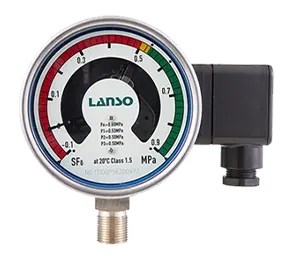In modern power systems, GIS (Gas Insulated Switchgear) is widely used for its fully enclosed structure and small footprint. However, fault location and maintenance inside GIS equipment are relatively difficult, and the outage maintenance time after a fault is usually much longer than that of open conventional equipment. To ensure the normal operation of GIS equipment, the application of SF6 gas density sensors becomes particularly important.
The Role of SF6 Gas Density Sensors
The SF6 gas density sensor is an important tool for monitoring the status of SF6 gas inside GIS equipment. SF6 gas, with its superior insulation performance, arc extinguishing performance, and heat dissipation performance, is filled into GIS equipment to maintain the safe operation of the equipment under high voltage conditions. Gas density sensors can monitor key parameters such as the pressure, micro water content, and temperature of the SF6 gas in real-time, thereby assessing the health status of the gas.
When the density of the SF6 gas is abnormal, the gas density sensor will promptly send an alarm signal, providing important grounds for equipment maintenance. This sensor uses wireless communication to transmit monitoring data to a self-developed application management system for integrated analysis in real-time. This process can effectively warn of potential equipment failures, ensuring the safety and reliability of electrical maintenance.
The Combination of Sensitivity and Convenience of the SF6 Gas Density Sensor
The SF6 gas density sensor features high sensitivity, stable wireless transmission, and convenient deployment. This sensor can flexibly adapt to different monitoring methods. By connecting node devices or software platforms, users can view data such as temperature, micro water, and pressure in real-time. Additionally, the system allows for querying historical data and setting data thresholds to achieve more intelligent monitoring management.
This flexible network feature makes substation monitoring more efficient. Whether adding new monitoring methods or expanding equipment, the SF6 gas density sensor can quickly connect to the existing network, achieving stable communication transmission. This not only improves the overall operating efficiency of the system but also significantly reduces equipment procurement and maintenance costs.
Thepre-warning and Dynamic Adjustment Function of the SF6 Gas Density Sensor
Another advantage of the SF6 gas density sensor is its pre-warning function. The edge framework carried by the access node can integrate application algorithms from various sensor manufacturers and third-party technology providers' APPs. By leveraging local data analysis and alarm push, the system can achieve dynamic strategy adjustments. For example, when gas density is abnormal, the system can automatically adjust the dehumidification mode or partial discharge collection cycle to avoid potential power accidents.
By moving previous back-end processing actions to the front end, the SF6 gas density sensor can detect problems in the initial stage of equipment abnormalities, greatly improving the safety of equipment operations. This intelligent monitoring method provides a new direction for the future development of the power industry.
The application of SF6 gas density sensors in GIS equipment not only ensures the safe operation of the equipment but also lays the foundation for the intelligent development of power systems. By monitoring the gas status in real-time, flexible networking, and pre-warning, the SF6 gas density sensor makes the maintenance of electrical equipment more efficient and safe. In the future, with continuous technological advancements, this sensor will play a more important role in the power industry, assisting in the stable operation and safe management of power equipment.







